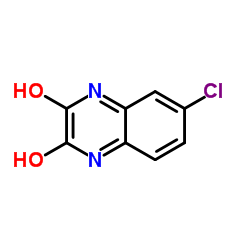6-Chloroquinoxaline-2,3-diol
Modify Date: 2025-08-25 11:22:54

6-Chloroquinoxaline-2,3-diol structure
|
Common Name | 6-Chloroquinoxaline-2,3-diol | ||
|---|---|---|---|---|
| CAS Number | 6639-79-8 | Molecular Weight | 196.590 | |
| Density | 1.7±0.1 g/cm3 | Boiling Point | 497.5±40.0 °C at 760 mmHg | |
| Molecular Formula | C8H5ClN2O2 | Melting Point | 250ºC | |
| MSDS | N/A | Flash Point | 254.7±27.3 °C | |
| Name | 6-chloro-2,3-dioxo-1,2,3,4-tetrahydroquinoxaline |
|---|---|
| Synonym | More Synonyms |
| Density | 1.7±0.1 g/cm3 |
|---|---|
| Boiling Point | 497.5±40.0 °C at 760 mmHg |
| Melting Point | 250ºC |
| Molecular Formula | C8H5ClN2O2 |
| Molecular Weight | 196.590 |
| Flash Point | 254.7±27.3 °C |
| Exact Mass | 196.003952 |
| PSA | 66.24000 |
| LogP | 3.43 |
| Vapour Pressure | 0.0±1.3 mmHg at 25°C |
| Index of Refraction | 1.761 |
| InChIKey | RNOLFZACEWWIHP-UHFFFAOYSA-N |
| SMILES | O=c1[nH]c2ccc(Cl)cc2[nH]c1=O |
| Storage condition | 2-8°C |
Synonym: Section 2 - COMPOSITION, INFORMATION ON INGREDIENTS
Risk Phrases: 36/37/38 Section 3 - HAZARDS IDENTIFICATION EMERGENCY OVERVIEW
Irritating to eyes, respiratory system and skin. Potential Health Effects Eye: Causes eye irritation. Skin: Causes skin irritation. May be harmful if absorbed through the skin. Ingestion: May cause irritation of the digestive tract. May be harmful if swallowed. Inhalation: Causes respiratory tract irritation. May be harmful if inhaled. Chronic: Not available. Section 4 - FIRST AID MEASURES Eyes: Flush eyes with plenty of water for at least 15 minutes, occasionally lifting the upper and lower eyelids. Get medical aid. Skin: Get medical aid. Flush skin with plenty of water for at least 15 minutes while removing contaminated clothing and shoes. Ingestion: Get medical aid. Wash mouth out with water. Inhalation: Remove from exposure and move to fresh air immediately. If not breathing, give artificial respiration. If breathing is difficult, give oxygen. Get medical aid. Notes to Physician: Treat symptomatically and supportively. Section 5 - FIRE FIGHTING MEASURES General Information: As in any fire, wear a self-contained breathing apparatus in pressure-demand, MSHA/NIOSH (approved or equivalent), and full protective gear. Extinguishing Media: Use water spray, dry chemical, carbon dioxide, or chemical foam. Section 6 - ACCIDENTAL RELEASE MEASURES General Information: Use proper personal protective equipment as indicated in Section 8. Spills/Leaks: Vacuum or sweep up material and place into a suitable disposal container. Section 7 - HANDLING and STORAGE Handling: Avoid breathing dust, vapor, mist, or gas. Avoid contact with skin and eyes. Storage: Store in a cool, dry place. Store in a tightly closed container. Section 8 - EXPOSURE CONTROLS, PERSONAL PROTECTION Engineering Controls: Facilities storing or utilizing this material should be equipped with an eyewash facility and a safety shower. Use adequate ventilation to keep airborne concentrations low. Exposure Limits CAS# 6639-79-8: Personal Protective Equipment Eyes: Not available. Skin: Wear appropriate protective gloves to prevent skin exposure. Clothing: Wear appropriate protective clothing to prevent skin exposure. Respirators: Follow the OSHA respirator regulations found in 29 CFR 1910.134 or European Standard EN 149. Use a NIOSH/MSHA or European Standard EN 149 approved respirator if exposure limits are exceeded or if irritation or other symptoms are experienced. Section 9 - PHYSICAL AND CHEMICAL PROPERTIES Physical State: Solid Color: Not available. Odor: Not available. pH: Not available. Vapor Pressure: Not available. Viscosity: Not available. Boiling Point: Not available. Freezing/Melting Point: 250 deg C (dec.) Autoignition Temperature: Not available. Flash Point: Not available. Explosion Limits, lower: Not available. Explosion Limits, upper: Not available. Decomposition Temperature: Solubility in water: Specific Gravity/Density: Molecular Formula: C8H5ClN2O2 Molecular Weight: 196.59 Section 10 - STABILITY AND REACTIVITY Chemical Stability: Not available. Conditions to Avoid: Incompatible materials. Incompatibilities with Other Materials: Strong oxidizing agents. Hazardous Decomposition Products: Hydrogen chloride, chlorine, nitrogen oxides, carbon monoxide, carbon dioxide. Hazardous Polymerization: Has not been reported Section 11 - TOXICOLOGICAL INFORMATION RTECS#: CAS# 6639-79-8 unlisted. LD50/LC50: Not available. Carcinogenicity: 6-Chloro-1,2,3,4-tetrahydroquinoxaline-2,3-dione - Not listed by ACGIH, IARC, or NTP. Section 12 - ECOLOGICAL INFORMATION Section 13 - DISPOSAL CONSIDERATIONS Dispose of in a manner consistent with federal, state, and local regulations. Section 14 - TRANSPORT INFORMATION IATA No information available. IMO No information available. RID/ADR No information available. Section 15 - REGULATORY INFORMATION European/International Regulations European Labeling in Accordance with EC Directives Hazard Symbols: XI Risk Phrases: R 36/37/38 Irritating to eyes, respiratory system and skin. Safety Phrases: S 26 In case of contact with eyes, rinse immediately with plenty of water and seek medical advice. S 37/39 Wear suitable gloves and eye/face protection. WGK (Water Danger/Protection) CAS# 6639-79-8: No information available. Canada CAS# 6639-79-8 is listed on Canada's NDSL List. CAS# 6639-79-8 is not listed on Canada's Ingredient Disclosure List. US FEDERAL TSCA CAS# 6639-79-8 is listed on the TSCA inventory. SECTION 16 - ADDITIONAL INFORMATION N/A |
| Hazard Codes | Xi |
|---|---|
| Risk Phrases | R36/37/38 |
| Safety Phrases | S26-S37/39 |
| HS Code | 2933990090 |
| HS Code | 2933990090 |
|---|---|
| Summary | 2933990090. heterocyclic compounds with nitrogen hetero-atom(s) only. VAT:17.0%. Tax rebate rate:13.0%. . MFN tariff:6.5%. General tariff:20.0% |
| 6-chloro-1,2,3,4-tetrahydroquinoxaline-2,3-dione |
| 6-chloro-1,4-dihydro-2,3-quinoxalinedione |
| 6-chloroquinoxaline-2,3-diol |
| 6-Chlor-1,4-dihydro-chinoxalin-2,3-dion |
| 2,3-quinoxalinediol, 6-chloro- |
| 2,3-Dihydroxy-6-chloroquinoxaline |
| 2,3-quinoxalinedione, 6-chloro-1,4-dihydro- |
| EINECS 229-647-9 |
| 6-chloro-1,4-dihydro-3-quinoxalinedione |
| MFCD00047592 |
| 6-Chloro-2,3-quinoxalinediol |
| 6-Chloro-2,3-dihydroxyqunoxaline |
| 6-CHLOROQUINOXAZALONE |
| 6-chloro-1,4-dihydroquinoxaline-2,3-dione |

